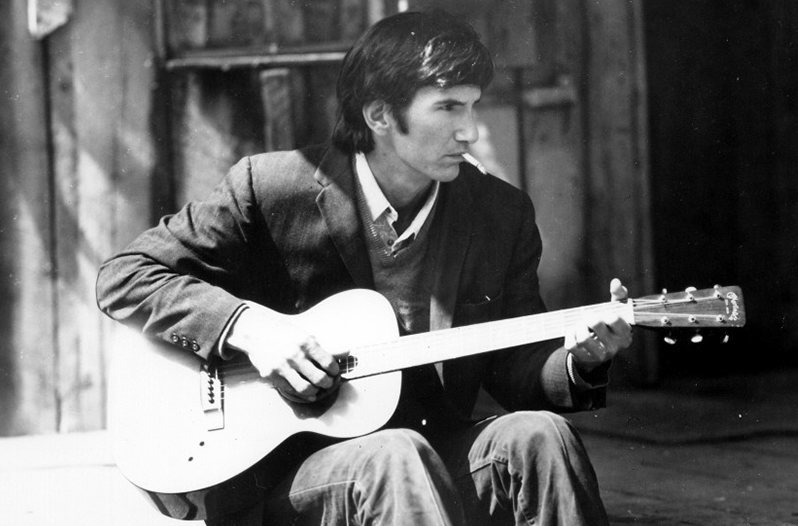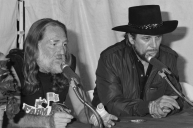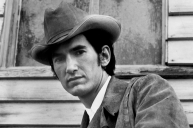[dropcap]B[/dropcap]orn March 7, 1944, in Fort Worth, Texas, singer-songwriter John Townes Van Zandt is the perfect example of an artist whose legend only grows with time. For many, Van Zandt was a walking paradox.
Videos by Wide Open Country
Somehow the greatest country songwriter to live is still not a household name among country music fans like Willie Nelson or Merle Haggard. A well-to-do kid born into comfort who lived his adult life in relative simplicity and poverty. An extremely intelligent man who somehow fell victim to the oldest trick in the book — addiction.
The "To Live is To Fly" and "Colorado Girl" singer suffered from bipolar disorder, yet painted pictures of life as a hero's journey, even if it felt like a Greek tragedy. He spun entertaining yarns alongside downtrodden narratives. And he always had a good joke.
But the best way to sum up his brilliant but troubling career as a writer and artist is through the words of his friends. His contemporaries — people like Guy Clark, Emmylou Harris, and Rodney Crowell — say without Townes Van Zandt, they wouldn't be here. And that should be enough to underscore his importance in the American Rolodex of songwriters, poets, and storytellers.
His albums, including Our Mother The Mountain, No Deeper Blue, Live at the Old Quarter, Houston, Texas, Flyin' Shoes, For the Sake of the Song, and Delta Momma Blues still influence new generations of musicians and songwriters. Sky Blue was even released posthumously in March 2019. Let's look at five stories that capture who Townes Van Zandt was.
5. Russian Roulette
Townes Van Zandt had a conflicted history with attention. He notoriously hated fame but commanded the attention of a room during his live performances. He could also shift his attitude on a dime, at one moment jovial and another somber. Steve Earle recounted a time when, during a small gathering of longtime friends, Earle felt the need to brandish a .357 Magnum handgun. Van Zandt, who had many songs about the perils of bravado, went from cordial to brash.
So he pulled out his own handgun, put some bullets in the chamber, put it up to his head, and pulled the trigger three times. Earle, a young protege of Van Zandt, got the message. Of course, given the path Townes continued to follow, he might as well have found one of the bullets.
Read More: Rare Video of Townes Van Zandt Performing "Pancho and Lefty" on Austin City Limits
4. The Attempted Sonic Youth Sessions
Van Zandt's uncanny ability to capture the heart of American melancholy resonated far beyond the country and folk worlds. In fact, Sonic Youth drummer Steve Shelley went to great lengths to find Van Zandt and record him. In early 1996, Shelley convinced Van Zandt to record a record that Shelley would put out through Sonic Youth's label. The album would be entirely funded by Geffen Records.
Van Zandt agreed, and the pair scheduled recording sessions in Memphis in December 1996. Shortly before the scheduled sessions, Van Zandt drunkenly fell down concrete stairs outside his home. He didn't know it at the time, but he broke his hip. Friends took him to their place where he stayed on the couch, unable to move. But he still wanted to record, so he had his friend and road manager, Harold Eggers, wheel him into the Memphis studio in a wheelchair. It didn't take long for Shelley to recognize Van Zandt's dire situation, and he canceled the sessions due to drunken, erratic behavior.
Van Zandt eventually returned to Nashville and went to the hospital, where doctors performed several surgeries. They warned that he needed to detox in the hospital, fearing a home detox could kill him. His ex-wife, unfortunately, did not heed their warnings, and with her help, Van Zandt subverted all medical advice. He died of a heart attack not long after, on Jan. 1, 1997.
3. Never On A Major Label
One of the main factors contributing to the legend of Townes Van Zandt is his beautiful loser ethos. The idea that he lived in obscurity and only achieved his worldwide inner circle acclaim after his death. While that's not entirely true — and while Van Zandt himself seemed to prefer the confines of poverty over fame — his work always came at his own behest.
Townes Van Zandt never recorded on a major label, which is rare given his contemporaries all recorded on major labels. And his most prolific years in the 1970s came at the height of the label structure. Remember, the means of recording and releasing music independently were difficult then, to say the least. But the fact that he could've secured major label representation and never did speaks volumes about Van Zandt's ethos. Eventually, his biggest fans (and some of the bigger musicians in the world) brought him to fame simply by recording his tunes, like "Pancho & Lefty," "If I Needed You," and "Tecumseh Valley."
2. Better Than Dylan?
Van Zandt's interesting history with Bob Dylan in many ways disproves the narrative that he went unappreciated much of his tragic adult life. The comparison between the two first made a splash on the cover of Van Zandt's only album released in the 1980s, At My Window (released in 1987).
That's when Steve Earle's infamous quote somehow made the sticker for the album: "Townes Van Zandt is the best songwriter in the whole world and I'll stand on Bob Dylan's coffee table in my cowboy boots and say that." The quirky quote, which embarrasses Earle still today, seemed like something that came straight from the mouth of Van Zandt, rather than an overzealous Earle. And it did not make Van Zandt happy, considering how much he hated the concept of celebrity.
He partially defused the situation by saying, "I've met Bob Dylan's bodyguards, and if Steve Earle thinks he can stand on Bob Dylan's coffee table, he's sadly mistaken." But Dylan was actually a huge fan of Van Zandt's, and Van Zandt first took a more serious look at songwriting thanks to Dylan's work in the 1960s. Still, Van Zandt ultimately turned down offers to write with Dylan, probably as part of his conflicted view of fame and attention related to songwriting.
1. "Tor-mentoring" Steve Earle
The dust-up with the Dylan quote aside, Steve Earle counted Townes Van Zandt as his mentor, and the two formed a close bond in the years since their initial encounter in 1978. But, as with much of Van Zandt's life, the relationship felt like the antithesis of what a mentor actually should be.
A 2009 New York Times article about Earle and Van Zandt captures that relationship perfectly. The first time Van Zandt watched Earle perform, he heckled him relentlessly, imploring Earle to sing "The Wabash Cannonball." He also told Earle to read War & Peace, and when Earle returned to him with questions about the book, Van Zandt revealed he himself hadn't actually read the book. He just thought Earle should.
Unfortunately, Earle also adopted Van Zandt's drug and alcohol habits. So bad, in fact, that Van Zandt actually visited Earle during a rare moment in which Townes was sober. "I must be in trouble if they're sending you," Earle said to Van Zandt. But despite all the joking, the two possessed an immense fondness and respect for each other. It's what led Earle to eventually name his son Justin Townes Earle after him.
Steve Earle wrote "Fort Worth Blues" as a tribute to his friend after his death in Smyrna, Tennessee, in 1997. The song remains one of his greatest songs. He also released an album called Townes in 2009, a dedication to his friend.
Now Watch: Miranda Lambert Songs We Can't Get Enough Of
https://rumble.com/embed/u7gve.v3v7xr/




